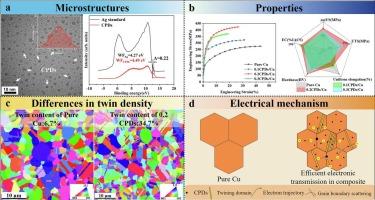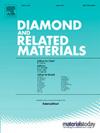Insights on the electrical conductivity enhancement mechanisms of carbon polymer dots (CPDs) reinforced Cu composites
IF 4.3
3区 材料科学
Q2 MATERIALS SCIENCE, COATINGS & FILMS
引用次数: 0
Abstract
Carbon polymer dots (CPDs) has represented unique potential in reconciling the incompatible properties of strength and electrical conductivity (EC) in copper matrix composites, while the mechanisms underlying EC improvement remain to be fully elucidated. 0.2CPDs/Cu composites prepared by conventional powder metallurgy processes achieves excellent mechanical and electrical conductivity simultaneously. Compared to pure Cu, CPDs not only participated in the construction of a better electronic transport pathway, but accelerated the twinning forming behavior, leading to outstanding strength(∼423 MPa) and electrical conductivity(95%IACS). Here the conductive behavior of CPDs/Cu composites was revealed through characterizing the intrinsic electrical properties of CPDs and composites microstructure evolution. CPDs not only participated in the construction of a better electronic transport pathway, but accelerated the twinning forming behavior. Increased twinning domain leads to the remarkable amelioration of grain boundary resistance, meanwhile, the intragranular CPDs made a significant contribution on the enhanced mechanical strength via Orowan strengthening. This work makes up the lack of understanding on the mechanical and electrical enhancement mechanism in our prior research.

碳聚合物点 (CPD) 增强铜复合材料导电性增强机制的启示
碳聚合物点(CPDs)在协调铜基复合材料的强度和导电性(EC)这两个不相容的特性方面具有独特的潜力,但导电性改善的机理仍有待全面阐明。采用传统粉末冶金工艺制备的 0.2CPDs/Cu 复合材料可同时获得优异的机械性能和导电性能。与纯铜相比,CPD 不仅参与构建了更好的电子传输通路,而且加速了孪晶形成行为,从而获得了出色的强度(∼423 MPa)和导电性(95%IACS)。本文通过表征 CPDs 的内在电学特性和复合材料的微观结构演化,揭示了 CPDs/Cu 复合材料的导电行为。CPD 不仅参与构建了更好的电子传输通路,还加速了孪晶形成行为。孪晶域的增加显著改善了晶界电阻,同时,粒内 CPD 通过奥罗旺强化对提高机械强度做出了重要贡献。这项工作弥补了我们之前研究中对机械和电气增强机制认识的不足。
本文章由计算机程序翻译,如有差异,请以英文原文为准。
求助全文
约1分钟内获得全文
求助全文
来源期刊

Diamond and Related Materials
工程技术-材料科学:综合
CiteScore
6.00
自引率
14.60%
发文量
702
审稿时长
2.1 months
期刊介绍:
DRM is a leading international journal that publishes new fundamental and applied research on all forms of diamond, the integration of diamond with other advanced materials and development of technologies exploiting diamond. The synthesis, characterization and processing of single crystal diamond, polycrystalline films, nanodiamond powders and heterostructures with other advanced materials are encouraged topics for technical and review articles. In addition to diamond, the journal publishes manuscripts on the synthesis, characterization and application of other related materials including diamond-like carbons, carbon nanotubes, graphene, and boron and carbon nitrides. Articles are sought on the chemical functionalization of diamond and related materials as well as their use in electrochemistry, energy storage and conversion, chemical and biological sensing, imaging, thermal management, photonic and quantum applications, electron emission and electronic devices.
The International Conference on Diamond and Carbon Materials has evolved into the largest and most well attended forum in the field of diamond, providing a forum to showcase the latest results in the science and technology of diamond and other carbon materials such as carbon nanotubes, graphene, and diamond-like carbon. Run annually in association with Diamond and Related Materials the conference provides junior and established researchers the opportunity to exchange the latest results ranging from fundamental physical and chemical concepts to applied research focusing on the next generation carbon-based devices.
 求助内容:
求助内容: 应助结果提醒方式:
应助结果提醒方式:


